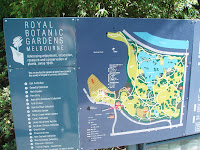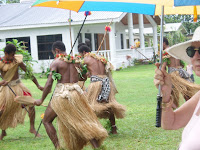




PORT DOUGLAS, AUSTRALIA February 28, 2008
Port Douglas is a small town far north in the state of Queensland. The town’s population quadruples with the influx of tourists during the peak tourism season May-September.
Port Douglas is near the Great Barrier Reef. There are numerous companies that run daily trips from the marina to the outer reef and the Low Isles for scuba diving and snorkeling. Port Douglas is also well known for it’s many restaurants, golf courses and five star resorts.
Today we visited a rain forest nature park to see many animals and plants that are not seen at home. We traveled through the rain forest in Army Ducks (really DUKW’s) and then into the water to see some aquatic plants and animals.
When we left the rain forest we boarded a scenic train to come down from the mountain. We traveled along the Barron River. At one point the river fell 1000 feet over the Barron Falls and it was spectacular. The picture we have of it doesn’t do justice to the beauty of the view.
I was particularly interested in the number of different types of termites. One of the species attacks a particular type of tree, the Black Wattle, and only eats the core of the tree. They leave to outside shell of the tree intact. Now the aborigines use this Black Wattle tree for their boomerangs. The aborigines also make a musical instrument called a didgeridoo. This is a 4 to 6 foot long and 3 to 4 inch in diameter straight piece of wood that is hollowed out. The player blows into the end of the instrument like a horn and produces a low buzzing sound. Anyway to make this instrument they simply take a log of the proper dimensions and stick it into a termite nest and in 9 to 12 months the log has been hollowed out and with some finishing touches the instrument is ready to go.
See some of the aborigines with their didgeridoo (see the man on the left) playing it and dancing on the deck of a tender from our cabin balcony.
We have with this stop visited 4 different cities in Australia from Melbourne in the south to Port Douglas in the north. Melbourne is about the same distance from the equator as Chicago and Port Douglas is equivalent to Miami. I am struck by the diversity of climates in the country of which I was not aware. Further to this surprise today we came down from a mountain peak to a seashore town filled with world-class resorts. We have similar resorts in the Miami area, but of course no mountains or rain forests. Again we find unexpected diversity.
Port Douglas is a small town far north in the state of Queensland. The town’s population quadruples with the influx of tourists during the peak tourism season May-September.
Port Douglas is near the Great Barrier Reef. There are numerous companies that run daily trips from the marina to the outer reef and the Low Isles for scuba diving and snorkeling. Port Douglas is also well known for it’s many restaurants, golf courses and five star resorts.
Today we visited a rain forest nature park to see many animals and plants that are not seen at home. We traveled through the rain forest in Army Ducks (really DUKW’s) and then into the water to see some aquatic plants and animals.
When we left the rain forest we boarded a scenic train to come down from the mountain. We traveled along the Barron River. At one point the river fell 1000 feet over the Barron Falls and it was spectacular. The picture we have of it doesn’t do justice to the beauty of the view.
I was particularly interested in the number of different types of termites. One of the species attacks a particular type of tree, the Black Wattle, and only eats the core of the tree. They leave to outside shell of the tree intact. Now the aborigines use this Black Wattle tree for their boomerangs. The aborigines also make a musical instrument called a didgeridoo. This is a 4 to 6 foot long and 3 to 4 inch in diameter straight piece of wood that is hollowed out. The player blows into the end of the instrument like a horn and produces a low buzzing sound. Anyway to make this instrument they simply take a log of the proper dimensions and stick it into a termite nest and in 9 to 12 months the log has been hollowed out and with some finishing touches the instrument is ready to go.
See some of the aborigines with their didgeridoo (see the man on the left) playing it and dancing on the deck of a tender from our cabin balcony.
We have with this stop visited 4 different cities in Australia from Melbourne in the south to Port Douglas in the north. Melbourne is about the same distance from the equator as Chicago and Port Douglas is equivalent to Miami. I am struck by the diversity of climates in the country of which I was not aware. Further to this surprise today we came down from a mountain peak to a seashore town filled with world-class resorts. We have similar resorts in the Miami area, but of course no mountains or rain forests. Again we find unexpected diversity.















































